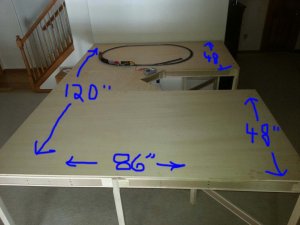hammerhead53
New Member
I just retired from BNSF after 40 yrs (former BN / CBQ) and have decided to try my hand at HO model railroading. I was told to make sure I had a good table before doing anything. The pic below is the table with bench work provided by Mianne Benchwork (www.miannebenchwork.com/). It's an awesome table and now I'm ready to move forward. Prior to building the table, I went to my local model RR shop (and that's all they sell) and told them what I was planning. They sold me the Bachman ATSF train set you see laid out (not much more then a terminal switching road...). This isn't what I had in mind but am open to most all suggestions. I have some questions going forward if someone can help.
The dimensions are noted on the pic. I'm currently looking at some sort of U config with appropriate sidings, etc. but am open to ideas.
1. Currently the table is 1/2" Sandeply plywood from Home Depot
2. Should I cover it with cork or foam or cloth or something?
3. Type of track to use. I see a lot of people use Atlas. If so, what do you attach it to the surface with?
4. Is it better to lay out the potential scenery first before the track?
5. Best brand of power and rolling stock to buy. I'm only looking for BN and it's former roads.
I'm sure I'll have more questions down the road but a little help with these for now will be appreciated.
The dimensions are noted on the pic. I'm currently looking at some sort of U config with appropriate sidings, etc. but am open to ideas.
1. Currently the table is 1/2" Sandeply plywood from Home Depot
2. Should I cover it with cork or foam or cloth or something?
3. Type of track to use. I see a lot of people use Atlas. If so, what do you attach it to the surface with?
4. Is it better to lay out the potential scenery first before the track?
5. Best brand of power and rolling stock to buy. I'm only looking for BN and it's former roads.
I'm sure I'll have more questions down the road but a little help with these for now will be appreciated.


